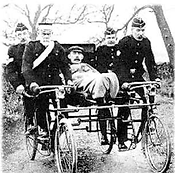
A HISTORY OF THE AMBULANCE
Timeline of Ambulance Development
Teams carrying bandages and water bottles ride behind fighting lines, bearing away the injured. Horse and foot soldiers earned a piece of gold for each life saved.
Invalids of rank transported on litter, cart or hammock.
Soldiers removed from civil war battlefields in wagons. Plague sufferers carried to plague-houses by fever-ambulance.
By the 18th century some hospitals, e.g. Staffordshire General Infirmary, had their own ambulance. A description from the era refers to ‘ A carriage hung upon strings, to be drawn by one or more horses for the conveyance of the sick or maimed.

ROMAN BRITAIN:
ANGLO-SAXON:
17th CENTURY:
18th CENTURY:

19th CENTURY:
1882:
1883:
1903:
In 1775 the first organised Ambulance service in Scotland was established.
The purchase of a pair of sedan chairs in Edinburgh was the beginning of the service, these were acquired on behalf of the doctors at the Royal Infirmary, for the "carriage of persons needful of medicinal enquiry yet unable to proceed thereto"
Increased use of ambulances across the country.
St John Ambulance Association introduce Invalid Transport Corps’ free of charge to the poor (becomes St John Ambulance Brigade in 1887).
Liverpool is the first town to have a regular, hospital-based, horse-drawn service equipped for first-aid and ready for immediate use.
Metropolitan Asylum Board introduce a steam powered vehicle with space for 8 stretchers.
Horse-drawn ambulances replaced by motor vehicles.
College of Ambulance opened in Newcastle-upon-Tyne as teaching of first-aid develops through the first-world war.
War-time ambulances released for civilian use and national ambulance service planned.
Register of national ambulance stations printed and circulated.
Public Health Act provides for transport of non-urgent cases and ambulance services spread slowly across the country until WW2.
999 telephone number introduced.
War-time civil defence and rescue provision consolidates ambulance services.
National Health Services Act requires local authorities to provide ambulances 'where necessary'. Initially staffed by volunteers, professionals are introduced gradually.
The Millar report recommends that the ambulance service should provide treatment as well as carry people to hospital.
Ambulance services transferred from local authorities to NHS control and performance standards set for ambulance trusts.
-
Modernisation of communications, vehicles and telephone systems e.g. introduction of helicopters and motorbikes to speed up response in difficult conditions
-
Computerised Defibrillators become portable and are introduced onto all ambulances
-
Staff with extended training re-qualify as Paramedics
Prioritisation of calls piloted.
Review of ambulances - focusing on performance standards. Sets out the performance standards in use today.
Prioritisation of calls used by all trusts.
New Emergency Care Practitioner role piloted.
National review of ambulance services.
1912 ONWARDS:
1912:
1918:
1920:
1925:
1937:
1939-1945:
1946:
1964:
1974:
1970 - 80:
1995/6:
1996:
2001:
2003:
2004/5:
1 / 6
